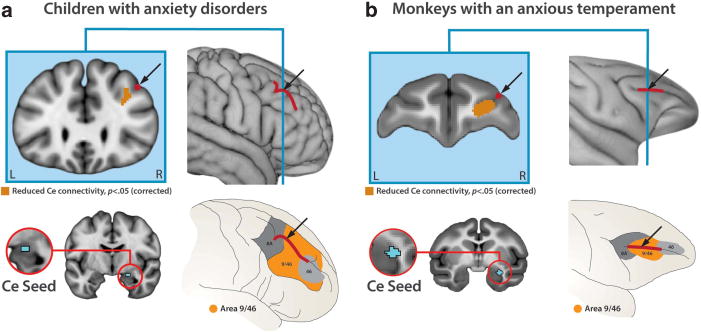RM Birn
RM Birn
1Department of Medical Physics, University of Wisconsin, Madison, WI, USA
2Department of Psychiatry, University of Wisconsin, Madison, WI, USA
3HealthEmotions Research Institute, University of Wisconsin, Madison, WI, USA
4Lane Neuroimaging Laboratory, University of Wisconsin, Madison, WI, USA
5Waisman Laboratory for Brain Imaging and Behavior, University Wisconsin, Madison, WI, USA
1,2,3,4,5,12,
AJ Shackman
AJ Shackman
6Department of Psychology, University of Maryland, College Park, MD, USA
7Neuroscience and Cognitive Science Program, University of Maryland, College Park, MD, USA
8Maryland Neuroimaging Center, University of Maryland, College Park, MD, USA
6,7,8,12,
JA Oler
JA Oler
2Department of Psychiatry, University of Wisconsin, Madison, WI, USA
3HealthEmotions Research Institute, University of Wisconsin, Madison, WI, USA
4Lane Neuroimaging Laboratory, University of Wisconsin, Madison, WI, USA
2,3,4,
LE Williams
LE Williams
2Department of Psychiatry, University of Wisconsin, Madison, WI, USA
3HealthEmotions Research Institute, University of Wisconsin, Madison, WI, USA
4Lane Neuroimaging Laboratory, University of Wisconsin, Madison, WI, USA
2,3,4,
DR McFarlin
DR McFarlin
2Department of Psychiatry, University of Wisconsin, Madison, WI, USA
3HealthEmotions Research Institute, University of Wisconsin, Madison, WI, USA
4Lane Neuroimaging Laboratory, University of Wisconsin, Madison, WI, USA
5Waisman Laboratory for Brain Imaging and Behavior, University Wisconsin, Madison, WI, USA
2,3,4,5,
GM Rogers
GM Rogers
2Department of Psychiatry, University of Wisconsin, Madison, WI, USA
2,
SE Shelton
SE Shelton
2Department of Psychiatry, University of Wisconsin, Madison, WI, USA
2,
AL Alexander
AL Alexander
1Department of Medical Physics, University of Wisconsin, Madison, WI, USA
5Waisman Laboratory for Brain Imaging and Behavior, University Wisconsin, Madison, WI, USA
1,5,
DS Pine
DS Pine
9Section on Development and Affective Neuroscience, National Institute of Mental Health, Bethesda, MD, USA
9,
MJ Slattery
MJ Slattery
2Department of Psychiatry, University of Wisconsin, Madison, WI, USA
2,
RJ Davidson
RJ Davidson
2Department of Psychiatry, University of Wisconsin, Madison, WI, USA
3HealthEmotions Research Institute, University of Wisconsin, Madison, WI, USA
5Waisman Laboratory for Brain Imaging and Behavior, University Wisconsin, Madison, WI, USA
10Department of Psychology, University of Wisconsin, Madison, WI, USA
11Center for Investigating Healthy Minds, University of Wisconsin, Madison, WI, USA
2,3,5,10,11,
AS Fox
AS Fox
2Department of Psychiatry, University of Wisconsin, Madison, WI, USA
3HealthEmotions Research Institute, University of Wisconsin, Madison, WI, USA
4Lane Neuroimaging Laboratory, University of Wisconsin, Madison, WI, USA
5Waisman Laboratory for Brain Imaging and Behavior, University Wisconsin, Madison, WI, USA
10Department of Psychology, University of Wisconsin, Madison, WI, USA
11Center for Investigating Healthy Minds, University of Wisconsin, Madison, WI, USA
2,3,4,5,10,11,
NH Kalin
NH Kalin
2Department of Psychiatry, University of Wisconsin, Madison, WI, USA
3HealthEmotions Research Institute, University of Wisconsin, Madison, WI, USA
4Lane Neuroimaging Laboratory, University of Wisconsin, Madison, WI, USA
5Waisman Laboratory for Brain Imaging and Behavior, University Wisconsin, Madison, WI, USA
10Department of Psychology, University of Wisconsin, Madison, WI, USA
2,3,4,5,10
1Department of Medical Physics, University of Wisconsin, Madison, WI, USA
2Department of Psychiatry, University of Wisconsin, Madison, WI, USA
3HealthEmotions Research Institute, University of Wisconsin, Madison, WI, USA
4Lane Neuroimaging Laboratory, University of Wisconsin, Madison, WI, USA
5Waisman Laboratory for Brain Imaging and Behavior, University Wisconsin, Madison, WI, USA
6Department of Psychology, University of Maryland, College Park, MD, USA
7Neuroscience and Cognitive Science Program, University of Maryland, College Park, MD, USA
8Maryland Neuroimaging Center, University of Maryland, College Park, MD, USA
9Section on Development and Affective Neuroscience, National Institute of Mental Health, Bethesda, MD, USA
10Department of Psychology, University of Wisconsin, Madison, WI, USA
11Center for Investigating Healthy Minds, University of Wisconsin, Madison, WI, USA
12These authors contributed equally to this work.



